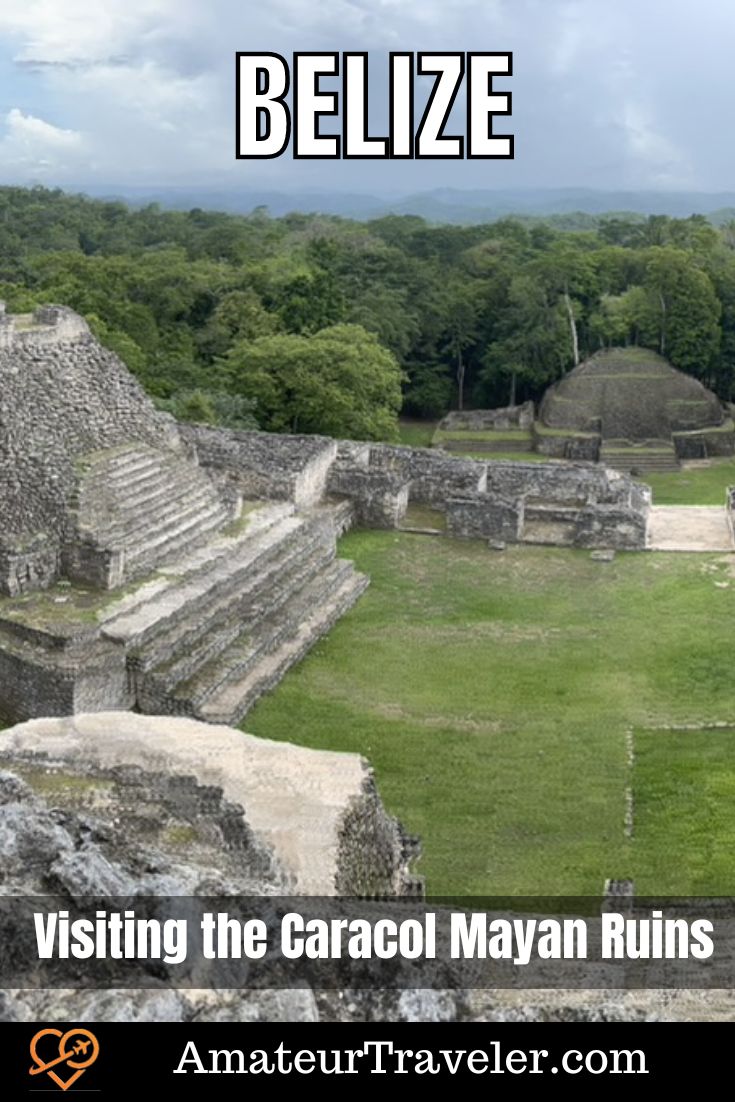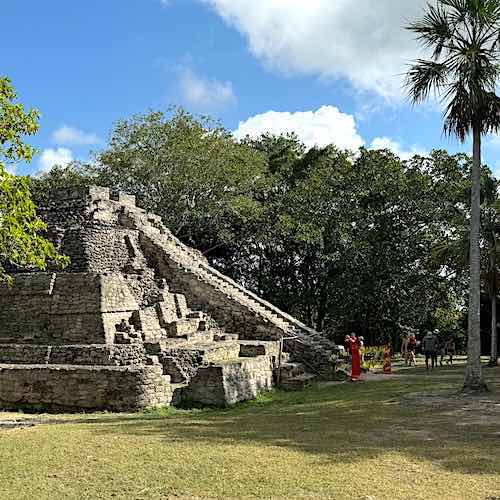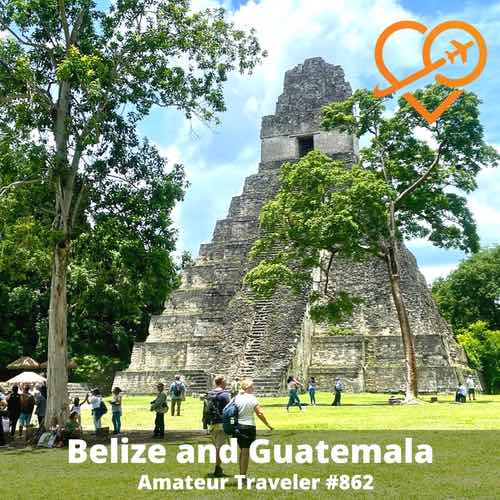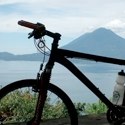
view from the Caana (Sky Palace)
I recently visited the Mayan ruins at Caracol as a day trip while on a G Adventures tour to Belize and Tikal (Guatemala). Caracol is an ancient Maya archaeological site located in present-day Belize. It was one of the most important ancient Maya city-states and played a significant role in the history and politics of the Maya civilization.
Today, Caracol does not have ruins as extensive as nearby Tikal in Guatemala, but it does not have the crowds that Tikal has. Plans are underway to increase tourism to Caracol, so that is one reason you should visit it today.
Table of contents: ()

Where is Caracol?
The Caracol Natural Monument Reservation is situated in the western part of Belize, south of San Ignacio, and only 5 miles from the Guatemalan border. Most guided tours of Caracol leave from San Ignacio.
Hours: 9 am – 5 pm
Entrance Fee: USD $7.50 / BZD $15
How to get to Caracol
In the past, access to the site was quite challenging due to the condition of the road. It was a rough, 5-hour journey from San Ignacio, and the road’s condition was so harsh on tour company vehicles that they couldn’t turn a profit by offering trips to the site. However, as part of an international effort to promote tourism, the road to Caracol is being paved. When I visited in 2023, it had been paved halfway.
In the coming years, you can anticipate larger buses from cruise ships making their way to the site. It still takes about 2 hours to reach the site, providing travelers with a free “Belize massage” during the latter part of the drive.
What does Caracol Mean?
Caracol comes from the Spanish word for snail. There is a story that the name comes from the discovery of snail shells at the site, but the name pre-dates that discovery. The name more likely comes from the winding road that leads to the site, resembling the shape of a snail’s shell.
History of Caracol
Caracol’s history can be traced back to the Middle Preclassic period (around 600 BC). During this time, it was a relatively small settlement. The city gradually developed over the centuries, building its infrastructure and population.
Caracol experienced its heyday during the Late Classic period (600-900 AD) when it became a major regional power. It engaged in both diplomatic relations and conflicts with neighboring Maya city-states, especially Tikal. Caracol’s rulers and elites constructed monumental architecture, including temples and pyramids, which showcased the city’s prosperity and prestige.
Like many other Maya city-states, Caracol faced a decline during the Terminal Classic period (900–1050 AD). This period saw the collapse of numerous Maya civilizations across the region, often attributed to factors such as environmental stress, warfare, resource depletion, and shifting trade routes. Caracol was ultimately abandoned around 1050 AD. The exact reasons for its decline are still debated among scholars although severe drought may have been one of the reasons for the collapse.
Archeology at Caracol
Caracol lay forgotten and covered by jungle until it was rediscovered in 1937 by Rosa Mai, a local logger.
The first archeologist to visit the site was the Archeological Commissioner of British Honduras (Belize), who visited in 1938. With so much of the ancient city covered by jungle, early archeology significantly underestimated its size. Anderson found a dozen Maya stelae (elaborately carved stone monuments) but was unimpressed with the site.
Linton Satterthwaite of the University of Pennsylvania systematically excavated and mapped the site in three sessions from 1950 to 1958. This early work helped us understand Caracol as the dominant city in the region between 560 and 690 AD.
Since 1985, the Caracol Archaeological Project, run by professors Diane and Arlen Chase, has conducted excavations at the site. Diane is currently the vice president and provost at the University of Nevada, Las Vegas, and Arlen is a faculty member in the anthropology department at Pomona College, Claremont, CA.
The National Center for Airborne Laser Mapping conducted the first LIDAR survey of the site in April 2009. It revealed a city that was 68 square miles and likely had a population of over 100,000, which is larger than Belize City is today.
While much more of Caracol might eventually be excavated, exposing the currently buried buildings will cause them to degrade much faster, so further excavations need to address both the expense of excavation and the issue of preservation.
Is visiting Caracol Safe?
Some time ago, there were issues with illegal activities in the Caracol area. The issues were serious enough that, for a time, the government used military caravans of cars to get people to and from the site. The last issues reported were in 2014, and visiting the site today is considered safe.
Guided Tour
I highly recommend taking a guided tour of Caracol. Unless you are already an expert in Mayan history, you will benefit from a knowledgeable guide.
I had the unique opportunity to tour the site alongside our guide, Leo, who had actively participated in the excavation for three seasons when the site was preparing for tourism around 2000. Leo was able to identify the buildings he had helped excavate and shared insights into the discoveries made in different nooks and crannies. Leo is also Mayan. While the Mayan civilization may have collapsed in the 900s, the Mayan people still live in the area.
Touring Caracol
Caracol has a small parking lot by the visitor center where you can park. The visitor center won’t take long to visit. As shown above, it has a site model and some historical information. Honestly, the visitor center could use some upgrades as most of the photos are faded, but the site does not get much tourism. During our visit, we saw no more than 3-4 cars in the parking lot, which seemed to be an entire day’s worth of tourists.
Monument Museum
Across the parking lot from the visitor center, there is a small collection of the original Mayan stelae found at Caracol. Anything you see in the park is a recreation, with the originals moved here and elsewhere to preserve them. Leo told us that a number of the original stelae were taken from the area never to be seen again. So, if you happen to know someone with Mayan sculptures in their backyard, Belize would like them back.
The Mayan stelae are crucial for dating Mayan sites as they are often used to depict the reign of particular rulers with dates that tie to the Mayan long calendar. Their absence from a site also tells its own story. For instance, for 125 years starting in 562 AD, there was a hiatus in the construction of stelae at Tikal. That is thought to be a time when it was dominated by Caracol.
Raleigh Group
Our first stop was at a set of four low stone platforms known as the Raleigh Group. This area was inside the walled center of the city of Caracol and is thought to be a residential area. These platforms would be the foundations of houses of people with some station. They were located near where the king lived, so perhaps they served the king. Archeologists found a small crypt inside the southernmost platform that you can still see today. The human remains of a child were found in the crypt.
Barrio Group
The Barrio Group is just off the city’s main plaza and is another residential area. Because of its proximity to the main plaza, this is thought to have been a royal residence. This was one of the spots where my guide Leo had specifically worked on excavating.
You will see some stonework on the site with a more finished appearance, and some left rough. The rough stonework is largely where reconstructing and stabilization work was done. It was left in this unfished state to help differentiate it from the original stonework.
When uncovered, the tops of these structures were covered with stucco in the Mayan tradition. It was intact at that time, with much of it still covered with red paint from the Mayan era, but twenty years of weathering and a large number of tourists walking on it have worn off almost all of the paint and left the stucco cracked and crumbling.
Look for alcoves with small stone beds raised a foot or so off the ground. These would have been sleeping areas, and the stone bed would have been covered by soft coverings.
The northernmost structure may have been a temple because of its rounded corners, which are often associated with such structures.
Caana (Sky Palace)
The most impressive structure in the Caracol site is the tallest pyramid, known as the Sky Palace (Caana in Mayan). It is 141 feet tall, making it the tallest archeological site in Belize. Excavating the Caana took a year and a half, and the back half of the temple was left covered with vegetation.
The Caana is topped with three different temples. It was built in the city’s later period around 800 AD. The Caana is the center of an extensive system of elevated roads that head off into the jungle for miles.
While the entire city was not abandoned until 1050 AD, the last recorded date found at Caracol corresponds to 859 AD and this structure was abandoned around 900 AD.
You can climb the Caana structure on the original steps and see where the stucco is crumbling. Before this site is opened to mass tourism, I think wooden steps will likely be constructed like the ones you will find at nearby Mayan sites like Tikal and Yaxha to protect the stonework.
At the top of the pyramid is royal housing, including this stone bed, which is a bit too short for someone who is 6′ 3″ tall. But if you like a firm mattress, this could be good for you.
- Get a universal plug adapter
- Search for Great Tours HERE
- Buy Travel Insurance
- Get a Car Rental
- Get an eSim to be able to use your smartphone abroad.
- Book Your Accommodation HERE

At the top of the Caana, there is an elevated plaza between the 3 temples. The rectangular area in the foreground of the picture above is a royal tomb that was found under the center temple as part of the excavation in 1986. Based on wall texts, the tomb dates to 634 AD. After it was excavated, it was filled in again.
Look to the left and the right of the staircase of the rightmost temple on the top of Caana to see two stone faces, a large one on the left and a small one on the right.
B5
Across the main plaza (B Plaze) from the Sky Palace is a structure named B5 by the archaeologists. This temple has two large stone faces on either side of its main stairs. Each face is roughly 9 feet tall and 8 feet wide. These are actually fiberglass replicas of the original faces, which are still in place just behind what you see.
The toothed-mouthed face on the left seems to be the rain god Tlaloc. As I understand it from Leo, the rain god worshiped by the Mayans in the Classical Age seems to have been more benevolent than the rain god Chaahk from later ages. Could a terrible drought change your perspective on how benevolent your rain god is?
A Plaza
The structure on the left (east) side of the A Plaza (A6) is thought to serve as an observatory. Some of the other structures in this plaza are still mostly covered with vegetation. This structure is believed to be the last building in Caracol to be abandoned.
Both A Plaza and B Plaza have a ball court, which is common to Mayan sites. We know that the game was played with a hard rubber ball that needed to be put through a stone ring, but there is debate about how often it was played and whether it was connected with ritual human sacrifice.
A Reservoir
The Mayans dug several reservoirs to supply the city with reliable water. Both the A Group and the B Group have one such reservoir. These were still watertight, at least until the archeological work of opening the site in the 2000s. At that point, the archeologists dug through the bottom of some of the reservoirs to study their construction.
South Acropolis
The South Acropolis is a more modest structure than the main plaza, but archeologists discovered a royal tomb in this area in 1992. This part of the city dates to the Early Classic period.
Conclusion
If you have ever pictured yourself as an archaeologist or explorer like Indian Jones or ever wanted to feel like you were in the jungle by yourself at an ancient Mayan site, then you should visit Caracol. This site will attract much more tourism in the years to come, but don’t wait for a smooth road and tour buses.
Take a guided tour with a wonderful guide. Get to Caracol now!
+Chris Christensen | @chris2x | facebook



















 Best Mayan Ruins Accessible by a Western Caribbean Cruise
Best Mayan Ruins Accessible by a Western Caribbean Cruise Travel to Belize and Guatemala – Episode 862
Travel to Belize and Guatemala – Episode 862 Travel to Belize – Episode 586
Travel to Belize – Episode 586 Biking Through Honduras, Guatemala and Belize – Episode 120
Biking Through Honduras, Guatemala and Belize – Episode 120

Sam Oppenheim
Says:September 17th, 2023 at 7:24 pm
Makes me want to go back to Belize again. I’m jealous you saw Tikal and caracol and the other site near Flores.
Truly a great blog post and a great site to recommend for visitors to Belize (except maybe for the dirt road ?) but I guess that’s changing soon